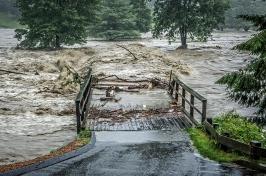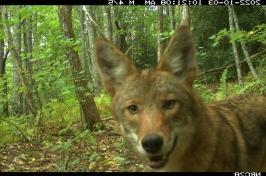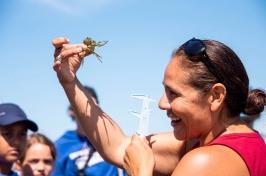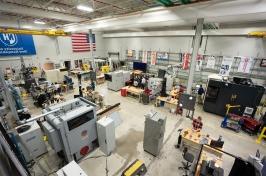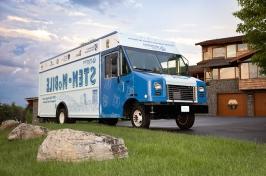Key Finding
Human hunting may unintentionally boost coyote populations by increasing reproduction and immigration rates, while competition with larger predators affects coyote numbers depending on habitat.
Once a rare sight in the northeastern United States, the eastern coyote has become a common presence across New Hampshire’s forests, farms and suburbs. First arriving in the state in the 1940s from the Midwest, these predators have since spread throughout every county and are keen adapters to regular interactions with humans, livestock and larger carnivores. The reasons for this adaptability, however, have remained understudied. A new study by researchers with the New Hampshire Agricultural Experiment Station (NHAES) at the University of New Hampshire (UNH) provides a detailed assessment of coyotes respond to environmental pressures, including hunting and competition with larger predators like black bears and pumas.
Published in the journal Ecography, the paper “People or predators? Comparing habitat‐dependent effects of hunting and large carnivores on the abundance of North America's top mesocarnivore” was co-authored by Station scientist Remington Moll, an assistant professor at UNH’s College of Life Sciences and Agriculture, and Roland Kays, a research professor with North Carolina State University’s College of Natural Resources. The study used data from over 4,500 camera traps set across the country by the SNAPSHOT USA project. Surprisingly, the study’s findings suggest that human hunting practices may actually contribute to increasing coyote numbers.
“Intensive coyote removal can obviously reduce populations in the short-term, but removal can also result in younger coyote populations with higher reproduction and immigration rates,” explained Moll. “In our study, we detected more coyotes in places where hunting was allowed. This change occurred over several years, suggesting that, on average, hunting did not reduce coyote abundance and perhaps increased it locally in certain areas.”
In addition to revealing that human hunting can lead to increases in coyote populations, the study also found that the presence of larger carnivores, such as black bears and pumas, influenced coyote numbers in a habitat-dependent manner. For example, black bears led to smaller coyote populations in forested areas, whereas pumas exerted a similar influence in more open environments.
“Our work suggests that promoting the recovery of large carnivores, especially in certain habitats, is more likely to reduce coyote numbers than people directly hunting them.” ~ Roland Kays, Research Professor, North Carolina State University’s College of Natural Resources
Coyote abundance was found to be highest in grasslands and agricultural operations—landscapes that provide ample prey and shelter. In more urban areas, coyote populations varied across urbanization scale. On smaller, local scales, urban development tended to reduce coyote numbers due to increased human presence and habitat fragmentation. However, at larger, suburban scales, coyote populations thrived, benefiting from the fragmented habitats and edges that offer access to both natural and human-modified resources.
The study also highlighted significant regional variation in coyote populations across the United States, with particularly high numbers in the southwestern U.S. and lower populations in the northeast, reflecting the diverse ecological and geographical factors at play.
“Many of the ecological relationships we found were expected,” said Kays. “But now that we have quantified them and can map them out across the country, we’re able to provide the first abundance map of our country’s most important predator.”
Moll and Kays’ study relied on camera trap data from SNAPSHOT USA, a national project that collects wildlife data from coordinated camera arrays across the contiguous United States. Incorporating data from 4,587 camera traps, it was one of the largest-scale studies of coyote populations to date. By covering a wide range of habitats—from rural to suburban—the SNAPSHOT USA dataset provided the researchers with a clearer understanding of how coyotes respond to varying environmental pressures. The data, analyzed using various advanced modeling techniques, allowed the team to evaluate the effects of habitat type, competition with larger carnivores, hunting practices and suburban expansion on coyote populations.
“The impressive SNAPSHOT USA project provides a yearly glimpse into our nation’s wildlife thanks to hundreds of researchers and the coordination by the Smithsonian and the North Carolina Museum of Natural Sciences,” said Moll. “By combining data from cameras with satellite-derived habitat metrics and advanced statistical models, we got an unprecedented look into continent-scale trends for this fascinating species.”
This research can better inform coyote management practices by showing the factors that most influence their abundance, Kays explained.
“In particular, our work suggests that promoting the recovery of large carnivores, especially in certain habitats, is more likely to reduce coyote numbers than people directly hunting them,” said Kays. “And this effort would help in both conservation efforts and coyote management.”
This work is co-authored by Remington J. Moll, Austin M. Green, Maximilian L. Allen and Roland Kays.
To learn more about this research, read People or predators? Comparing habitat‐dependent effects of hunting and large carnivores on the abundance of North America's top mesocarnivore, published in the Ecography.
This material is based on work supported by the NH Agricultural Experiment Station through joint funding from the USDA National Institute of Food and Agriculture (under McIntire-Stennis award number 7003422) and the state of New Hampshire. Additional support came from the Illinois Natural History Survey, the University of Illinois, the Global Change and Sustainability Center at the University of Utah, Sageland Collaborative, and grants from the National Science Foundation (2206783, 2211768).
-
Written By:
Nicholas Gosling '06 | COLSA/NH Agricultural Experiment Station | nicholas.gosling@parkviewhousebb.com























